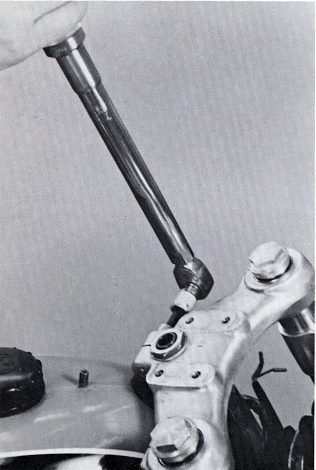
FIG. 185
16. At this point, tighten each fork tube pinch bolt evenly to 10 ft. lbs. torque.
17. Tighten the Allen clamp bolt on the top yoke. This is the bolt that pinches the steering shaft. Torque it to 15 ft. lbs. torque. (Fig. 185)

FIG. 185
18. Tighten the 27 mm nut on the top yoke to 35 ft. lbs. torque.
19. Hold the right side of the axle and tighten the axle nut to 60 ft. lbs. On the 5-speed Plonker, hold the left side of the axle and torque the nut to 50 ft. lbs.
20. Tighten only the left axle pinch bolt to 15 ft. lbs. torque. On the 5-speed PI onker, tighten only the right one to 15 ft. lbs. torque.
21. With the right axle pinch bolt loose (left bolt on 5-speed Plonker), pump the forks up and down eight or ten times. This allows the right fork slider leg to move slightly from right to left and when the forks are pumped up and down, it can move to align itself, reducing the chance of the forks binding. Now tighten the right axle pinch bolt to 15 ft. lbs. torque. On the Plonker, tighten the left pinch bolt to 15 ft. lbs. torque.
22. On Pioneer and Plonker models, tighten the headlight mounting brackets. On the Stiletto, replace the number plate, fastening it in place with the elastic strap.
23. Move the forks from right to left. If they are hard to move, the steering bearings will need to be loosened. With both wheels on the ground, have someone hold the rear brake on. Grasp the front wheel in one hand, and put the fingers of your other hand at the point where the top yoke and the steering head come together. Now try to rotate the wheel back and forth. (Fig. 186) If, while you are doing this, you can feel any movement between the yoke and the steering head, this means the bearings are too loose and will need to be tightened.
Page 144